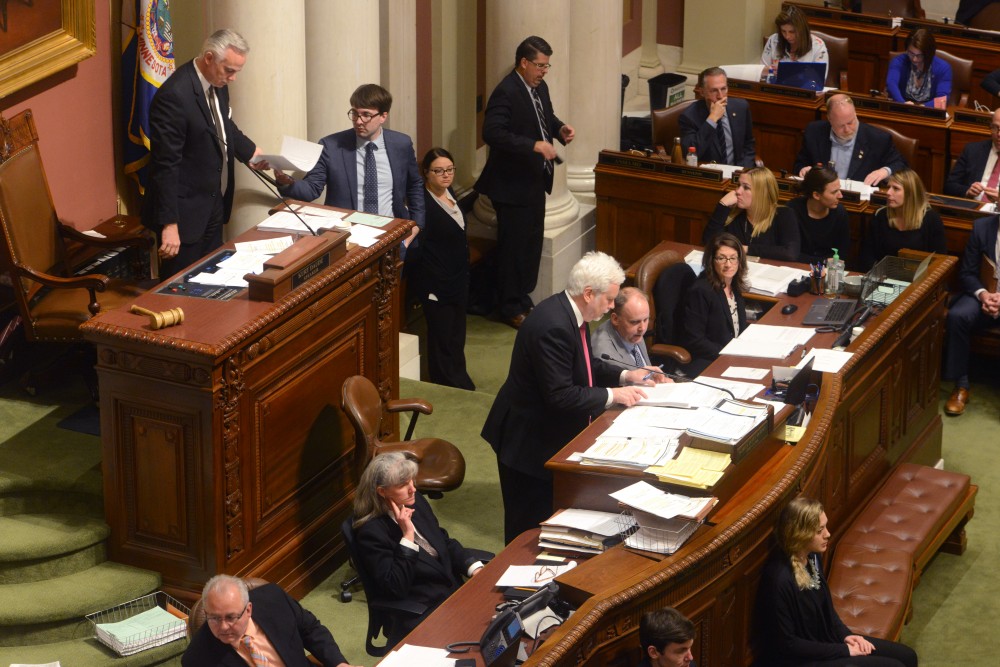Gov. Mark Dayton signed the higher education omnibus and bonding bills into law on Tuesday, finalizing University of Minnesota funding.
University leaders welcomed some aspects of both bills, but noted shortcomings that could lead to tuition increases.
The final higher education bill gives the University a $54.6 million increase, 37.1 percent of the University’s request of a $147.2 million increase.
The bonding bill was more fruitful for the University, as a total of $119.9 million funded four of its seven building and maintenance projects.
“We are grateful for the Governor’s and the Legislature’s support of the University this session,” said University President Eric Kaler in a Friday statement.
Higher Education Bill
After the regular session ended May 22, legislative leaders reached a final decision on the higher education bill.
The current higher education bill adds $54.6 million in state funding to the University over the next biennium, an amount some school officials feel should have been higher.
The previous bill’s increase of $18.6 million in funding, about a third of the current bill’s increase, was widely criticized by students and administrators alike.
The current bill was more accepted, but the new increase is still about a third of the University’s original request of a $147.2 million increase and some University officials say it may cause a tuition hike.
To hold tuition steady, the University would instead need a $128.6 million increase in state funding, said University spokesperson Emmalynn Bauer in an email.
“Tuition increases, in combination with program cuts, are the only levers we have to maintain mission-driven activities of the University,” Kaler said in the statement.

Even with a $1.6 billion budget surplus and a stronger economy than recent years, the University “continues to be on a losing streak” at the capital, said Larry Jacobs, director of the Center for the Study of Politics and Governance at the Humphrey School of Public Affairs.
In the last several decades, the state hasn’t kept up with the University’s costs, Jacobs said.
The University can no longer be considered a place where anyone can get an affordable education if state funding continues in this direction and tuition keeps rising, Jacobs said.
“My heart is with the students … they are the losers,” Jacobs said. “They will have to work longer hours and take out more loans.”
But Matt Kramer, University vice president for government relations, said getting the Legislature to agree with the University has always been difficult and required compromise.
“It doesn’t matter who’s in charge, it doesn’t matter what party — it’s always been a challenge. And the challenge for us is you can never take anything for granted,” Kramer said.
Bonding Bill
While state and federal higher education funding have been going down, Kramer said “I look at things like the capital request on bonding, and the state really stepped forward in a giant way.”
The University received $119.9 million of its $245.1 million capital request for projects like a health sciences facility on the Twin Cities campus and a new chemistry building on the Duluth campus.
“We did phenomenally well … our capital request is either number two or number three in the last 20 to 30 years in terms of how much money we got from the state”, Kramer said.
In his statement, Kaler expressed gratitude that some school projects would get all or almost all their funding. These projects included new facilities for plant growth research and health sciences education and a new science building for chemistry and advanced materials on the Duluth campus.
However, the Higher Education Asset Preservation and Replacement project received only a fifth of its requested for $100 million.
Kramer said the project is difficult to fund because it’s unexciting.
“[It’s like] having to swing by your hardware store to fix a leaky pipe,” Kramer said. “There’s not a lot of celebration around that, but you know you have to do it.”
Three other projects, like the Pillsbury Hall renovation, did not receive funding but were ranked by the University as lower priorities than those which received funding.
Student leaders respond
Zach Sheffler, speaker of the Council of Graduate Students, said he would be concerned if nonresidents receive a great increase to their tuition rates as graduate students often live out-of-state or internationally more than undergraduates.
Graduate student assistantships tend to cover about half of graduate students’ tuition, so individual departments will have to pay for more if tuition increases, Sheffler said.
Trish Palermo, president-elect of the Minnesota Student Association, said the result reinforces a need for student advocacy at the capitol.
Palermo said any tuition increases would impact the most vulnerable, like those with low-incomes or first-generation students.








